Salted Fish Fried Rice: Simple Thai Comfort Meal You’ll Love
Salted Fish Fried Rice is more than just a meal. It’s a flavorful window into Thailand’s culinary soul, bringing together humble ingredients like fermented fish, fluffy jasmine rice, and zesty aromatics to create a dish that hits every note salty, savory, and satisfying.
At Just Thai Recipes, we believe food should tell a story, and this dish does exactly that. As shared on our About page, our passion for Thai cuisine began in a small kitchen where traditions passed down from generations were given new life. This blog was born out of a desire to preserve that authenticity while making Thai food accessible for every home cook.
Salted Fish Fried Rice exemplifies that mission. It’s comfort food that carries bold flavor, rich history, and versatility in every bite. From Bangkok night markets to home kitchens in Los Angeles, people seek out variations like Salted fish fried rice near me and Salted fish fried rice recipe because it’s that crave-worthy.
In this detailed guide, we’ll cover everything you need to know to master this Thai classic at home. Whether you’re wondering what fish is used for salted fish fried rice, how to prep salted fish, or just want a flavor-packed meal tonight, this guide delivers. Let’s explore the ingredients, technique, and tips that make this dish an icon.
Table of Contents
Table of Contents
Understanding Salted Fish Fried Rice
What is Salted Fish Fried Rice?
Salted Fish Fried Rice is a Thai dish made by stir-frying jasmine rice with diced salted fish, marinated chicken, scrambled eggs, fresh aromatics like green onions and ginger, and Thai seasonings such as fish sauce and white pepper. The magic lies in the balance—salted fish delivers bold umami, the rice adds texture, and the vegetables bring freshness.
It’s a staple across Thailand, popular in homes, street food stalls, and even upscale restaurants. Its flavor is immediately recognizable—savory, slightly smoky from the seared fish, and deeply comforting. For anyone searching for salted fish fried rice near me, chances are they’re craving that addictive aroma and taste that only this dish can deliver.
Why It’s So Popular
There are many reasons Salted Fish Fried Rice has reached iconic status:
- Bold Flavor: Salted fish is intensely savory, making this fried rice more flavorful than standard versions
- Simplicity: With just a few core ingredients, it’s easy to make yet incredibly satisfying
- Customizable: You can swap chicken for tofu, add chilies for heat, or toss in extra veggies
- Quick Cooking: Once the prep is done, the entire dish comes together in under 15 minutes
This versatility and bold flavor are why it remains one of the most searched Thai dishes on the internet. Whether it’s a late-night craving or a way to impress guests, Salted Fish Fried Rice delivers.
The Difference Between Thai and Chinese Salted Fish Fried Rice
You may be wondering how Thai-style differs from Chinese-style salted fish fried rice. Both are delicious, but they have distinct characteristics:
| Feature | Thai Style | Chinese Style |
|---|---|---|
| Salted Fish Type | Dried or brined, often less pungent | Strongly fermented and more intense in aroma |
| Seasonings | Fish sauce, white pepper, ginger | Soy sauce, Shaoxing wine, garlic |
| Cooking Style | High-heat wok stir-fry | Clay pot or pan-fried |
| Additions | Chicken, eggs, lettuce | Diced pork, spring onions, bell peppers |
Both versions are worth trying, but Thai Salted Fish Fried Rice tends to lean lighter and more aromatic. When people search for Salted fish Chinese style or Salted fish fried rice wiki, they’re often comparing the differences between these two cultural approaches.
Origins and Cultural Significance
Salted fish has been used in Southeast Asia for centuries as a way to preserve seafood without refrigeration. In Thailand, preserving fish with salt allowed communities to keep food on hand during monsoon seasons or fishing off-seasons.
Over time, Thai cooks began adding small bits of these preserved fish into stir-fried rice to elevate flavor. Today, Salted Fish Fried Rice is a comfort dish that brings nostalgia for home to many Thai families around the world.
In regions like Southern Thailand, salted fish is even used during festivals and communal gatherings. The dish has found its way to Western plates too, as Thai restaurants across the globe introduce diners to this bold, satisfying recipe.
Are you ready to cook this iconic dish in your kitchen? In the next section, we’ll break down the ingredients what you need, what you can substitute, and why each plays a key role.
Key Ingredients in Salted Fish Fried Rice
The Essential Ingredients List
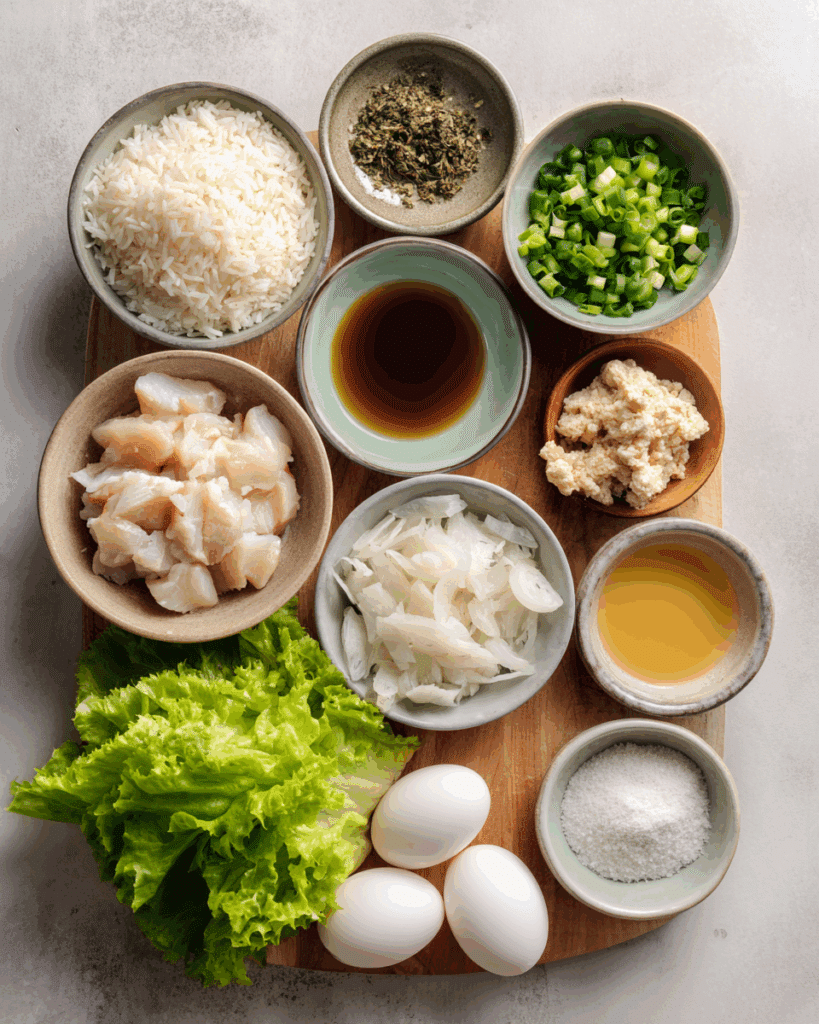
To make authentic Salted Fish Fried Rice, choosing the right ingredients is crucial. Each component plays a role in flavor, texture, and balance. Let’s walk through each one and understand how it builds the dish.
1. Thai Jasmine Rice (12 oz, uncooked)
This fragrant, long-grain rice is the ideal base for any Thai fried rice. When cooked and fluffed, it offers a slightly sticky yet separate texture, perfect for absorbing savory flavors from the salted fish and sauces. Freshly steamed rice is too soft for frying, so it’s best to use day-old or chilled rice.
2. Salted Fish (2 oz)
The heart of the dish. Salted fish is preserved in salt, then dried or fermented. The Thai variety tends to be less pungent than Chinese-style salted fish, but still brings deep umami. Diced into tiny pieces, it crisps up when fried, infusing the rice with bold flavor.
3. Chicken Breast (4 oz)
Chicken adds a mild richness and bite. It’s marinated in oyster sauce, white pepper, and cornstarch to stay tender during stir-frying. While traditional, it’s also optional—you can go vegetarian or swap in tofu or shrimp.
4. Green Onions (1 oz)
Used both for flavor and garnish, green onions bring freshness and a bit of crunch. Both the white and green parts are used.
5. Ginger (0.50 oz)
Sliced into thin strips, ginger brightens the dish and helps cut through the salty fish. It also complements the aromatic nature of jasmine rice.
6. Lettuce (3 oz)
Yes, lettuce. Added at the end, it wilts slightly, adding texture and a refreshing bite that balances the saltiness.
7. Large Eggs (2)
Eggs are scrambled and folded in for protein, color, and softness. Fried rice without eggs feels incomplete in Thai cuisine.
8. Oil (2 tbsp)
Oil is added in stages throughout cooking to help ingredients sear, not steam. Wok cooking needs enough heat and fat to create that signature smoky flavor.
9. Fish Sauce (2 tsp)
This is a staple Thai seasoning made from fermented anchovies. It deepens the flavor of the entire dish and enhances umami.
10. White Pepper (0.25 tsp)
More floral and earthy than black pepper, it gives warmth without overwhelming heat.
Looking for inspiration? Try our Thai Pineapple Fried Rice which uses similar rice techniques and flavor layering.
Marinade Ingredients: The Flavor Foundation
Marinating the chicken ensures each bite is juicy and well-seasoned. Here’s what goes into the marinade:
- Oyster Sauce (1 tbsp): Brings savory depth with a touch of sweetness
- White Pepper (0.13 tsp): Adds subtle spice
- Cornstarch (1 tsp): Helps the chicken stay tender
- Water (1 tbsp): Loosens the mix for even coating
Even a quick 10-minute marinade makes a difference, but for deeper flavor, let it rest for 30 minutes.
If you love rich, savory marinades, don’t miss our Massaman Chicken Curry which uses similar base ingredients in a comforting coconut curry.
Ingredient Substitutions and Tips
If you can’t find traditional Thai salted fish at your local store or you’re not sure where to buy salted fish for fried rice, here are options:
| Ingredient | Substitution or Tip |
|---|---|
| Salted Fish | Use anchovies or dried sardines, chopped finely |
| Thai Jasmine Rice | Use basmati rice if unavailable, but avoid short-grain |
| Fish Sauce | Soy sauce or tamari for a less intense version |
| Chicken | Tofu, shrimp, or even mushrooms work great |
Check out our Hainan Chicken Rice for another dish where rice and protein work in harmony.
Ingredients That Elevate the Dish
Salted Fish Fried Rice can be customized further. Additions like Thai bird chilies, diced carrots, or bell peppers can introduce color and heat. A few drops of lime juice or a side of sliced cucumber also help cut the richness.
When people look up Salted fish fried rice ingredients or Salted fish fried rice wiki, they’re often trying to understand how simple components combine into such a satisfying meal. And now, you do too.
Step-by-Step Recipe Instructions
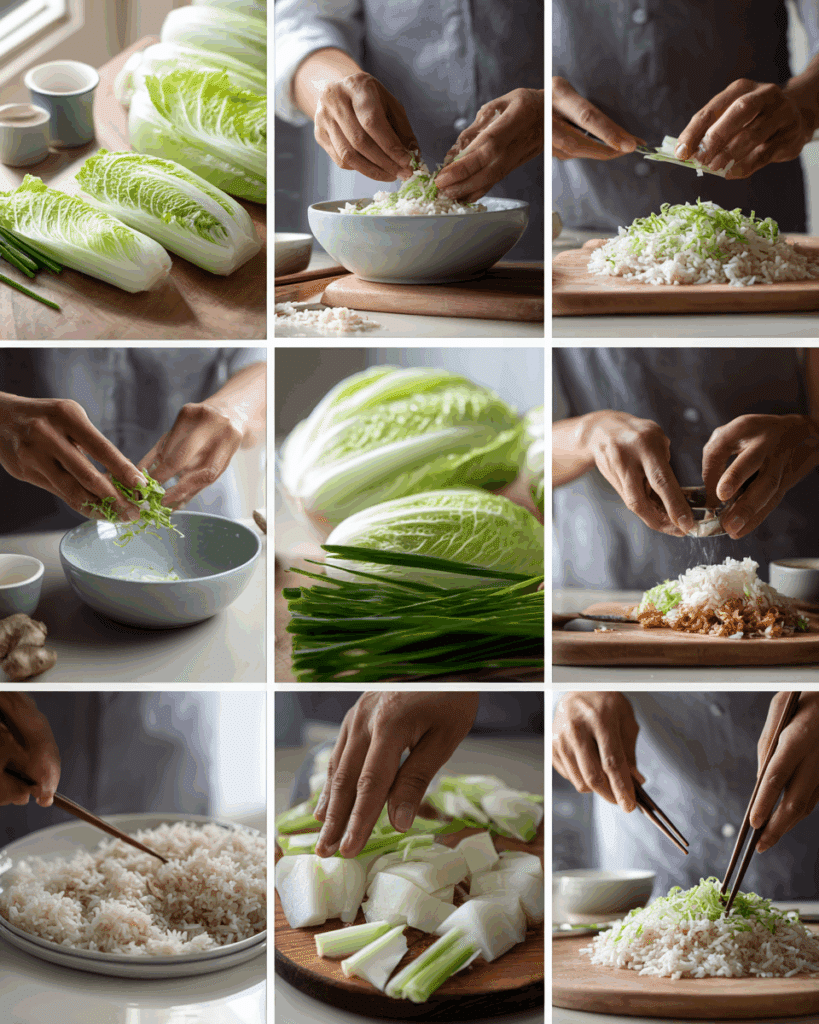
Step 1: Cook the Jasmine Rice
Start by washing 12 oz of Thai jasmine rice 2 to 3 times. This removes excess starch that could make your rice clump or get gummy during frying. Drain well each time until the water runs clearer.
Add the rice and 10 oz of water to your rice cooker pot. Once placed in the cooker, activate it and let the rice steam fully. This should yield fluffy but firm grains. The secret to good fried rice is using rice that’s had time to dry a little—day-old or chilled rice works best because it stays separate during stir-frying.
Pro Tip: If you don’t have time to chill your rice overnight, you can spread freshly cooked rice on a tray and refrigerate it for 30 minutes.
For more techniques on how professional chefs handle rice prep, explore this helpful guide from Made With Lau, where Chef Randy breaks down how rice texture makes or breaks this dish.
Step 2: Prepare the Aromatics and Vegetables
A great Salted Fish Fried Rice relies heavily on well-prepared aromatics. Dice 1 oz of green onions, using both the white and green parts. These not only add freshness but are crucial to the finishing touch.
Peel and wash 0.50 oz of ginger. Cut into thin slices, then into matchsticks. Ginger adds sharpness and aroma that balances the strong salted fish flavor.
Rinse 3 oz of fresh lettuce. Peel off individual leaves, stack them together, and slice into thin ribbons. Lettuce is stirred in last to keep its crisp-tender texture.
This method aligns with the Cantonese variation explained at The Woks of Life, where the importance of proper knife work and timing is emphasized in preserving the crunch of added vegetables.
Step 3: Marinate and Prep the Chicken
Cut 4 oz of chicken breast into small cubes—about 1/2 inch each. This size ensures quick, even cooking without drying out.
Place the chicken in a bowl and add:
- 1 tablespoon oyster sauce
- 0.13 teaspoon white pepper
- 1 teaspoon cornstarch
- 1 tablespoon water
Mix thoroughly to coat all pieces. Let it sit for at least 10 minutes at room temperature. The cornstarch creates a velvety texture when seared, while the oyster sauce infuses flavor deeply.
You can refer to the technique shared on What To Cook Today, where marinating is emphasized as essential for soft and juicy meat even after high-heat stir-frying.
Step 4: Prepare the Salted Fish
Take your 2 oz of salted fish and begin by removing the head if it hasn’t been pre-trimmed. Use kitchen shears to snip off the dorsal fins along the back. Rinse the fish under water to eliminate excess surface salt, then gently pat it dry with paper towels.
Deboning is key. Use a small sharp knife to remove the spine and any lingering bones. Cut the flesh into strips, then dice into small, pea-sized chunks.
Chef’s Tip: The smaller the pieces, the more surface area caramelizes during stir-frying, enhancing both aroma and texture. This preparation also prevents any one bite from being overwhelmingly salty.
If you prefer milder flavor, use a smaller quantity or choose a less fermented salted fish. Cantonese-style fish tends to be stronger and saltier, while Thai varieties are more balanced.
Step 5: Stir-Fry the Eggs and Chicken
Crack 2 large eggs into a bowl and beat gently.
Heat a wok on high heat, add 0.32 tablespoon of oil, and pour in the eggs. Scramble them quickly, stirring for 20 to 30 seconds until they’re just cooked but still soft. Remove and set aside.
In the same wok, add another 0.32 tablespoon of oil. Add the marinated chicken. Stir-fry for about 1 minute or until the chicken is about 90% cooked. Remove and set aside with the eggs.
By cooking them separately, you maintain the texture and avoid overcooking either protein.
Step 6: Combine and Finish the Stir-Fry
Now it’s time to bring all the flavors together.
Heat 1 tablespoon of oil in the wok. Use your spatula to coat the sides, ensuring nothing sticks. Add the julienned ginger and diced salted fish. Stir-fry for about 1 minute until aromatic. You’ll notice a rich, savory smell that signals the fish is crisping up perfectly.
Add your pre-cooked rice to the wok. Stir-fry for 1.5 to 2 minutes, breaking up any clumps with your spatula. Be patient here—frying the rice thoroughly ensures flavor distribution and that perfect smoky wok hei.
Add in the scrambled eggs and stir-fry for 40–50 seconds.
Add the cooked chicken, increase the heat slightly, and stir-fry again for another 40–50 seconds to combine all the proteins.
Toss in the green onions and 0.25 teaspoon of white pepper. Stir-fry another 40–50 seconds.
Turn the heat to low. Taste and adjust seasoning. Salted fish is naturally salty, so use fish sauce cautiously. Start with 2 teaspoons of fish sauce and adjust if needed.
Turn off the heat and fold in your sliced lettuce. The residual heat softens the lettuce without making it soggy.
For a glossy finish, drizzle in the remaining 0.32 tablespoon of oil, turn the heat back on to high, and give it one final stir for 1 minute.
Plating the Perfect Fried Rice
Scoop the finished fried rice into a bowl and press it gently to compact. Place a plate over the bowl, press down, and flip it over. Lift the bowl to reveal a neatly shaped dome of salted fish fried rice.
Garnish with extra green onions or fresh chilies if you like some heat.
This careful preparation and layering of steps mirror the techniques found in many traditional Chinese and Thai kitchens, as shown in the external recipes we referenced above. Whether you’re making this for a weekday meal or a weekend dinner party, it’s bound to impress.
Preparing the Salted Fish in More Detail
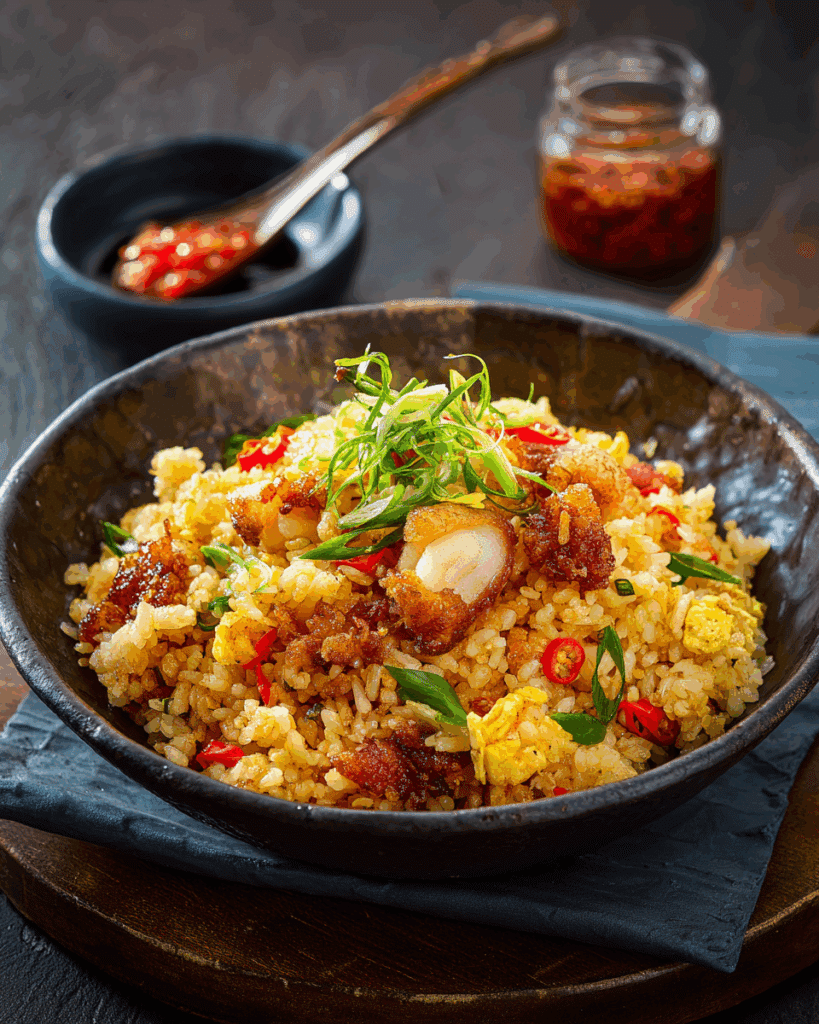
Choosing the Right Salted Fish
Salted fish is the backbone of this dish. Its savory intensity is what sets Salted Fish Fried Rice apart from other fried rice variations. Choosing the right kind of salted fish can dramatically affect the final result. Thai-style salted fish is usually less pungent and drier than the Chinese fermented varieties. Look for fillets that are firm and have a clean, oceanic smell. Avoid overly moist or sticky versions, which can indicate poor storage or fermentation that’s gone too far.
Dried salted mackerel, anchovies, or threadfin bream are all excellent choices. Make sure the fish is free from mold and excessive salt crystallization on the outside. The texture should be pliable but not mushy. A good piece of salted fish should break into firm flakes once cooked.
Cleaning and Prepping the Salted Fish
Before using it, salted fish needs to be cleaned and prepped properly. This step reduces excessive saltiness and enhances the final aroma of the dish. Begin by rinsing the fish under cool water to remove surface salt and any dust from packaging. Then pat it dry thoroughly with a clean paper towel.
Using a sharp knife or kitchen shears, trim away the head and dorsal fins if present. Some varieties of salted fish come pre-trimmed, but many still require basic butchery. Always lay the fish flat and work with care to avoid tearing the flesh.
Deboning is essential. Run your fingers along the spine and locate any pin bones. Use the tip of a small knife to gently pull them out. It’s okay if you need to slice the fish into two fillets to make this easier. Once deboned, cut the fish into thin strips, rotate them 90 degrees, and dice into small cubes. Aim for pea-sized pieces. This size allows the fish to cook quickly and evenly, adding bursts of umami without overpowering each bite.
Handling the Aroma
Salted fish has a strong smell that intensifies when it hits a hot wok. While it may be a bit overwhelming during cooking, it mellows out as it mixes with the rice and aromatics. Proper ventilation is helpful. Open windows or turn on your exhaust fan before cooking. If you’re new to working with salted fish, start with a smaller quantity. You can always add more the next time once you’re comfortable with its strength.
Many Thai cooks recommend lightly frying the salted fish before combining it with other ingredients. This not only reduces the sharpness of the smell but also crisps up the edges of the fish, adding texture. The frying also deepens the flavor, making it richer and nuttier.
Adjusting to Taste
The quantity of salted fish used should be proportional to the amount of rice. Too much will make the dish overly salty and fishy. A good rule of thumb is to start with about two tablespoons of diced salted fish for every three cups of cooked rice. After frying and mixing with the rice, taste test the dish before adding extra fish sauce or seasonings.
If the flavor still feels too bold, balance it with fresh components like lettuce, cucumber slices, or a squeeze of lime. These ingredients cut through the saltiness and bring balance.
Storing Salted Fish
Unused salted fish should be wrapped tightly in parchment paper or plastic and stored in an airtight container. It can last several weeks in the refrigerator and even longer if frozen. Always keep it separate from other foods due to its strong smell. When ready to use again, allow it to come to room temperature before slicing to ensure easier cutting and better texture during cooking.
Preparing salted fish with care is what transforms this dish from average to exceptional. In the next section, we’ll take a closer look at stir-frying the proteins and bringing the whole dish together with the right timing and heat.
Stir-Frying the Proteins
Getting the Wok Ready
To create an authentic Salted Fish Fried Rice, you need to stir-fry your proteins properly. This step is crucial to developing deep flavors and the signature texture of the dish. Start by heating your wok over high heat. The wok should be hot enough that a drop of water sizzles and evaporates instantly. Once hot, add a small amount of oil, just enough to coat the surface. This ensures your ingredients won’t stick and helps them sear instead of steam.
Cooking the Eggs
Crack two large eggs into a bowl and beat them gently until the yolks and whites are fully combined. Pour a bit of oil into the hot wok and swirl to coat. Add the eggs quickly and stir them with your spatula. Cook for about twenty to thirty seconds. The goal is to keep the eggs soft and fluffy, not overcooked. Once they are set but still moist, remove them from the wok and set them aside. These eggs will be added back later to blend with the rice and absorb all the flavors from the salted fish and seasonings.
Scrambling the eggs first and removing them ensures they won’t be overcooked or broken into tiny bits during the final stir-fry. This step maintains their texture, color, and richness throughout the Salted Fish Fried Rice.
Searing the Chicken
Next, heat the wok again and add a little more oil. Drop in the marinated chicken. The marinade, made with oyster sauce, cornstarch, white pepper, and water, helps the chicken remain tender and flavorful. Spread the chicken evenly across the surface of the wok so it sears properly. Let it sit for a few seconds before stirring to allow the surface to caramelize.
Stir-fry the chicken over medium-high heat for about one minute, until it is ninety percent cooked. You want it to be lightly golden on the outside but still slightly underdone in the center. This is because it will return to the wok later and finish cooking with the rice.
Once done, remove the chicken and set it aside along with the eggs. Keeping each protein separate ensures they cook properly and do not overcrowd the wok, which can cause ingredients to release moisture and turn soggy.
Timing and Sequence
In stir-frying, timing and sequence are everything. By cooking the eggs and chicken separately and adding them back later, you preserve their individual textures while allowing them to blend perfectly into the dish. This method also ensures the Salted Fish Fried Rice has layers of flavor instead of a one-dimensional taste.
It’s important to work quickly and keep the wok hot throughout each stage. If the heat drops, the ingredients will steam instead of fry, which affects both texture and flavor. Always prepare all your ingredients in advance and have them within reach. This will make your cooking process smooth and efficient.
Maintaining Texture
The proteins in Salted Fish Fried Rice contribute more than just flavor. They add body and contrast to the dish. The eggs give creaminess, while the chicken adds bite and substance. Each element should be lightly browned on the outside and juicy inside. Avoid overcooking, as dry protein can make the dish feel heavy or bland.
Using fresh, good-quality chicken and properly beaten eggs ensures the dish retains its richness. When combined with salted fish later, these proteins will soak up the surrounding flavors and bring balance to the saltiness of the fish.
In the next section, we’ll bring everything together. You’ll learn how to finish the dish by adding the aromatics, incorporating the proteins and rice, and building that unmistakable wok-fried flavor.
Combining Everything to Complete the Salted Fish Fried Rice
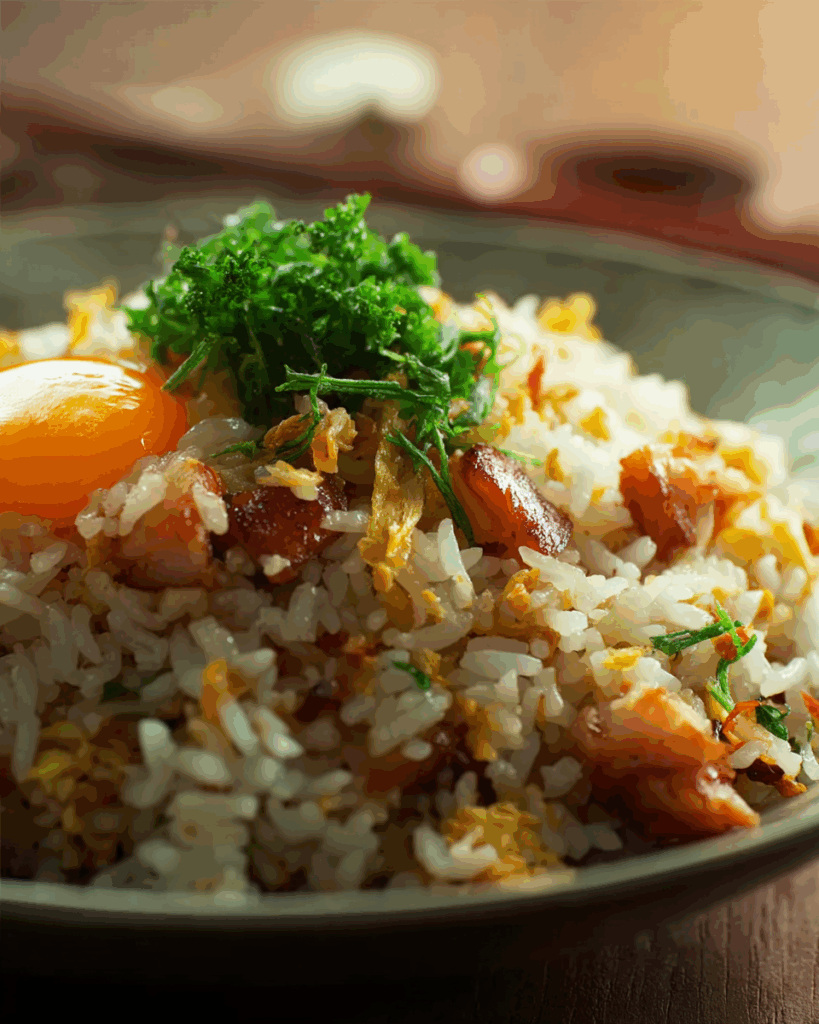
Heating the Wok Again
Now that your proteins are ready, it’s time to bring all the elements together to create an unforgettable plate of Salted Fish Fried Rice. Start by heating the wok once more over high heat. This step is critical. The wok must be hot enough to sizzle the ingredients instantly. This intense heat helps create wok hei, that smoky aroma and flavor that defines authentic Thai and Chinese-style fried rice.
Add one tablespoon of oil and use your spatula to coat the bottom and sides. This ensures an even surface for the ingredients to sear properly without sticking or clumping.
Sautéing the Salted Fish and Aromatics
Add the finely diced salted fish into the hot oil. Stir-fry quickly for about one minute. You should notice the fish releasing its signature aroma as it begins to sizzle and turn golden. The tiny cubes will crisp up slightly, giving texture and infusing the oil with rich, savory flavor. This is the heart of the Salted Fish Fried Rice and sets the foundation for every other ingredient.
Immediately follow with the julienned ginger. Stir-fry it with the fish until aromatic. The ginger not only adds a fresh, zesty kick but also balances the intensity of the salted fish with its warming properties. This combination builds a strong flavor base before the rice is even added.
Stir-Frying the Rice
Add the chilled, cooked jasmine rice into the wok. Break up any clumps gently using the edge of your spatula. Stir-fry the rice for one and a half to two minutes. The rice should begin to heat through and absorb the flavors from the salted fish and ginger. Keep the rice moving constantly to prevent sticking and to ensure it cooks evenly.
The rice will begin to take on a golden color as it interacts with the seasoned oil and fish. This is when the Salted Fish Fried Rice starts to come to life. You’ll see steam rising and notice the grains separate beautifully, creating that fluffy yet slightly chewy texture you want in every bite.
Adding the Cooked Eggs and Chicken
Return the scrambled eggs and partially cooked chicken to the wok. Stir everything together thoroughly, making sure to distribute the proteins evenly throughout the rice. Stir-fry for another forty to fifty seconds, allowing the chicken to finish cooking and the eggs to break up slightly as they integrate into the rice.
This step is where all the ingredients begin to meld. The saltiness from the fish, the richness from the eggs, the tenderness of the chicken, and the depth from the seasoned oil all come together to define the character of a well-made Salted Fish Fried Rice.
Final Seasoning Touches
Sprinkle in the diced green onions and a quarter teaspoon of white pepper. Stir-fry again for another forty to fifty seconds. The green onions add color and freshness, while the white pepper brings a subtle heat that blends into the background without overwhelming the other flavors.
At this point, turn the heat to low. Taste the rice. Since salted fish is already salty, you may find that the dish needs little to no additional seasoning. If desired, add two teaspoons of fish sauce to round out the flavor. Do not add it all at once—add gradually and taste as you go to avoid overpowering the dish.
Turn off the heat after seasoning, then gently fold in the thinly sliced lettuce. The residual heat will slightly wilt the lettuce, adding a tender crunch that contrasts with the rice and proteins. This is one of the final touches that makes Thai-style Salted Fish Fried Rice unique.
Final Stir and Shine
Turn the heat back up to high one last time. Add the final third of a tablespoon of oil and stir the rice vigorously for about one minute. This last round of high-heat frying gives the dish its glossy, appetizing look and slightly caramelizes the rice around the edges. You should smell toasted rice, warm ginger, and the lingering aroma of the salted fish.
The entire wok should be sizzling and steaming at this point. Keep stirring until everything is evenly coated, hot, and flavorful. Then immediately remove the wok from the heat to prevent overcooking.
The Perfect Fried Rice Texture
Your Salted Fish Fried Rice is now complete. The rice should be fluffy, each grain separate yet infused with flavor. The fish should be crispy and aromatic without being too strong. The eggs should remain soft, and the chicken should be juicy and tender. The lettuce should be lightly wilted but still vibrant and slightly crisp. Every component contributes to a dish that is bold, balanced, and deeply satisfying.
This final stir-fry stage is not just about mixing. It’s where the magic happens, where each flavor finds its place, and the dish truly earns its name. Salted Fish Fried Rice, when made with this careful layering of ingredients and timing, becomes more than food it becomes comfort on a plate.
Presentation and Serving Tips for Salted Fish Fried Rice
Creating an Impressive Plate
Salted Fish Fried Rice deserves a presentation that reflects the effort and bold flavor behind it. How you serve this dish impacts the eating experience just as much as how it’s cooked. In Thai kitchens and restaurants, visual appeal is always part of the final step. Whether you’re preparing it for family or guests, taking a few extra minutes to plate it beautifully can elevate the entire meal.
One classic method is using a small bowl to shape the rice. Scoop the hot Salted Fish Fried Rice into the bowl and press it gently to compact the grains. Be careful not to mash it—just enough pressure to hold the shape. Then place a plate over the bowl, flip it quickly but smoothly, and lift the bowl off. What you’ll get is a neat, dome-shaped mound of Salted Fish Fried Rice that looks clean, professional, and ready to impress.
Garnish with a few thin slices of fresh chili or a sprinkle of extra green onions on top. This not only adds color contrast but also gives a subtle spice and crunch that complements the saltiness of the dish.
Pairing Suggestions for Salted Fish Fried Rice
While Salted Fish Fried Rice is filling and flavorful on its own, thoughtful sides can enhance the experience and provide a more complete meal. A simple Thai cucumber salad is one of the most popular pairings. The freshness and slight sweetness of the cucumber cuts through the saltiness of the salted fish, balancing each bite.
Another excellent companion is a fried egg with a runny yolk. When placed on top of the hot Salted Fish Fried Rice, the yolk creates a rich, creamy sauce that coats the rice grains and adds an extra layer of indulgence. You can also consider grilled vegetables or lightly steamed bok choy as simple sides that don’t compete with the bold flavor of the main dish.
If you enjoy heat, a side of Thai chili vinegar or fresh chili fish sauce can add a customized spice level without altering the flavor foundation of the Salted Fish Fried Rice.
Best Time to Serve Salted Fish Fried Rice
This dish is incredibly versatile in terms of when to serve it. Salted Fish Fried Rice makes a hearty lunch, especially for those who crave something savory and filling during the day. It’s also perfect for dinner, particularly when you’re short on time but still want a dish with depth and satisfaction. It’s quick to make once the prep is done and fits beautifully into both casual weeknight meals and special occasions.
You can even serve smaller portions of Salted Fish Fried Rice as part of a larger Thai food spread. Its strong flavor pairs well with milder dishes like steamed jasmine rice, satay, or coconut-based soups.
Portioning Tips
When serving Salted Fish Fried Rice, portion size matters. Because the dish is rich and salty, moderate servings are usually enough to satisfy most appetites. For adults, one bowl per person is standard, while kids may enjoy half a bowl depending on their preferences.
If you’re preparing the dish for a gathering, consider doubling the recipe and serving it family-style in a large, shallow bowl. This allows guests to help themselves and makes it easy to pair with other dishes on the table.
Salted Fish Fried Rice also holds well in a warm oven for short periods, so you can prepare it slightly ahead of time and keep it ready to serve without sacrificing quality.
Presentation for Takeout or Packed Lunch
If you’re packing Salted Fish Fried Rice for lunch or meal prep, it’s important to preserve its texture. Let the fried rice cool slightly before placing it in containers. This prevents condensation from forming inside the lid, which can make the rice soggy. Use shallow containers for better cooling and portion control. Keep the garnish separate and add it right before eating to maintain freshness.
Salted Fish Fried Rice makes an excellent next-day lunch. The flavors continue to develop as it rests, making leftovers almost better than the original serving. Just be sure to reheat it properly. A quick toss in a hot skillet is preferred over microwaving, as it revives the rice’s texture and reactivates the aromas.
Making Salted Fish Fried Rice Party-Ready
If you’re planning to serve Salted Fish Fried Rice at a party or potluck, it’s a great idea to turn it into a rice bar. Offer a base of Salted Fish Fried Rice with toppings on the side such as chopped cilantro, sliced red chilies, crispy shallots, fried egg strips, or even diced mango for a sweet contrast.
Guests can personalize their bowls, and it turns the dish into an interactive and engaging experience. This setup works well for both casual and formal events, and it ensures that everyone gets a plate full of flavors they love.
Salted Fish Fried Rice is more than just a tasty meal. It’s a conversation starter, a comfort food, and a cultural classic all rolled into one. When plated and served thoughtfully, it leaves a lasting impression that goes beyond the table.
Nutritional Breakdown and Health Insights of Salted Fish Fried Rice
Understanding the Nutritional Value
Salted Fish Fried Rice is not only delicious but also surprisingly balanced when prepared correctly. While it’s known for its strong flavors and comforting texture, it also offers a variety of essential nutrients. This section breaks down the key components of Salted Fish Fried Rice to help you understand its health profile and make informed choices.
When cooked with lean chicken, eggs, fresh vegetables, and moderate oil, Salted Fish Fried Rice can provide protein, healthy fats, fiber, and carbohydrates. The key is portion control and ingredient balance.
A typical serving of Salted Fish Fried Rice contains jasmine rice, chicken breast, diced salted fish, scrambled eggs, green onions, ginger, and lettuce. These ingredients work together to deliver a satisfying meal that provides both energy and nourishment.
Approximate Caloric Breakdown per Serving
- Thai Jasmine Rice (1 cup cooked): 200 calories
- Chicken Breast (2 oz): 90 calories
- Salted Fish (1 oz): 50 calories
- Eggs (1 large): 70 calories
- Vegetable oil (1 tbsp total used): 120 calories
- Lettuce, green onions, ginger: 20 calories
- Fish sauce and seasonings: 10 calories
Total (per bowl-sized serving): Approximately 560 calories
This estimate can vary depending on portion size and the amount of oil used. However, Salted Fish Fried Rice can easily fit into a balanced diet, especially when served with fresh sides or paired with a light soup.
Protein and Carbohydrate Balance
Salted Fish Fried Rice offers a balanced mix of macronutrients. The chicken and eggs provide lean protein, while the rice supplies complex carbohydrates to keep you energized. Salted fish, though used in smaller amounts, adds a concentrated source of protein and flavor.
One serving of Salted Fish Fried Rice typically offers between 20 and 25 grams of protein. That’s ideal for sustaining muscle repair and keeping you full longer. The carbohydrate content, mostly from jasmine rice, provides steady energy, making it a great lunch or dinner option.
Sodium and Salt Awareness
Since Salted Fish Fried Rice includes preserved fish and fish sauce, it naturally contains more sodium than a plain rice dish. A typical serving can contain around 900 to 1100 milligrams of sodium. While this is within daily limits for most people, those watching their sodium intake may want to reduce the amount of salted fish used or substitute with lower-sodium fish sauce.
To lower the sodium content without compromising flavor, you can also increase the fresh vegetable content or use low-sodium broth to deglaze the wok while cooking. Balancing the dish with raw cucumber, lime wedges, or steamed greens on the side helps mellow out the saltiness naturally.
Good Fats and Healthy Oils
The oil used in Salted Fish Fried Rice contributes healthy fats, particularly if you use high-quality vegetable oil, sunflower oil, or even avocado oil. Using just enough oil to cook the ingredients without overdoing it helps maintain a light texture and lower overall fat content.
Most of the fat in this dish comes from the cooking oil and egg yolks, which offer healthy unsaturated fats when consumed in moderation. Salted Fish Fried Rice made at home gives you full control over these quantities, unlike takeout versions that often use excessive oil or additional butter.
Fiber and Micronutrients
Salted Fish Fried Rice includes a generous helping of fresh vegetables like lettuce, green onions, and ginger. These ingredients contribute vitamins such as A, C, and K, along with minerals like potassium and iron. Lettuce and ginger also aid digestion, especially in a heavier dish like this one.
The use of fresh ginger offers anti-inflammatory benefits and helps with metabolism. Green onions provide antioxidants, and lettuce contributes hydration and a small dose of dietary fiber. Adding even more vegetables like carrots, bell peppers, or bean sprouts can boost the fiber content and enhance the dish’s nutritional profile.
Making Salted Fish Fried Rice More Health-Friendly
Here are a few tips to keep Salted Fish Fried Rice both flavorful and aligned with health goals:
- Use brown jasmine rice or mixed grain rice for added fiber
- Reduce the amount of oil by using non-stick cookware
- Increase the volume of fresh vegetables
- Use low-sodium fish sauce or soy sauce alternatives
- Portion the dish into smaller servings and serve with a light broth
Salted Fish Fried Rice can be part of a health-conscious meal plan if prepared thoughtfully. It offers complex flavor and texture while delivering real nutritional value. Whether you’re counting calories, watching sodium, or just trying to eat better without sacrificing taste, this dish can absolutely fit your lifestyle.
Salted Fish Fried Rice is not only satisfying and filling, but also a smart choice when you want a single-bowl meal that doesn’t feel overly heavy. The balance of protein, rice, and vegetables makes it a complete meal on its own. By making small adjustments, it can be even healthier without losing the bold taste that makes Salted Fish Fried Rice so popular.
Salted Fish Fried Rice can be enjoyed by nearly anyone, and with the right ingredients and awareness, it becomes a nutritious staple instead of an indulgence. Whether you’re serving it at home or packing it for work, Salted Fish Fried Rice proves that comfort food can also be smart food.
Conclusion: Why Salted Fish Fried Rice Deserves a Place in Your Kitchen
Salted Fish Fried Rice isn’t just another fried rice recipe—it’s a bold, fragrant, and culturally rich dish that stands out for its deep umami flavor, crispy textures, and comforting warmth. What makes Salted Fish Fried Rice truly special is its simplicity combined with intensity. Just a few ingredients like jasmine rice, diced salted fish, and basic aromatics come together to create a dish that satisfies deeply and lingers in memory.
We’ve walked through every step, from choosing and preparing the salted fish to perfecting the stir-fry method and presentation. Along the way, we’ve seen how every detail matters—from the temperature of the wok to the timing of adding ingredients. These small choices turn a basic rice dish into a layered and flavorful experience.
Salted Fish Fried Rice is more than just food. It’s heritage. It’s comfort. It’s a culinary bridge between generations and cultures. Whether you’re making it for yourself, your family, or your friends, this dish delivers bold taste, nourishing ingredients, and a story with every bite.
Next time you’re looking for something hearty, authentic, and unforgettable, remember Salted Fish Fried Rice. It’s the dish that proves simple ingredients can create extraordinary flavor when handled with care.
FAQs About Salted Fish Fried Rice
What is salted fish?
Salted fish is a type of preserved seafood that has been cured using salt. The preservation process may involve drying or fermentation depending on the regional method. It’s a centuries-old technique used across many cultures to store fish without refrigeration. In Salted Fish Fried Rice, the fish is usually pre-soaked or rinsed to reduce excess salt, then chopped into small pieces before being fried. Salted fish adds umami, saltiness, and aroma, making it the centerpiece of Salted Fish Fried Rice recipes around the world.
What does “fried salted fish” mean?
Fried salted fish is simply salted fish that has been pan-fried or wok-fried until it becomes crispy and aromatic. In the context of Salted Fish Fried Rice, the fish is cut into small pieces and fried at the beginning of the stir-fry process. This step allows the flavor to infuse into the oil, which then coats the rice and other ingredients. Fried salted fish delivers texture and an intense salty depth that cannot be replicated by fresh fish or seasoning alone. This frying method is what gives Salted Fish Fried Rice its signature taste.
What is salted fish Chinese style?
In Chinese cuisine, salted fish refers to fish that has been preserved using salt and fermentation. It’s stronger in aroma and taste compared to Thai salted fish. Chinese-style salted fish is commonly used in clay pot dishes and stir-fries, including their version of Salted Fish Fried Rice. The Chinese style tends to use fermented fish that’s oilier and saltier, which results in a more pungent fried rice. While both styles use salted fish as the base flavor, Thai Salted Fish Fried Rice is generally milder and more aromatic.
What is Salted Fish Fried Rice?
Salted Fish Fried Rice is a traditional Asian dish made by stir-frying jasmine rice with diced salted fish, scrambled eggs, chicken, vegetables, and aromatic seasonings. It’s especially popular in Thai and Chinese cuisines. The salted fish infuses the rice with a bold, savory flavor that sets it apart from other fried rice varieties. The dish is often customized with various proteins and vegetables, but the salted fish remains the hero ingredient. Salted Fish Fried Rice is a go-to meal for those who love rich, umami-packed comfort food.
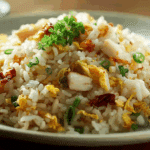
Salted Fish Fried Rice
- Prep Time: 20 minutes
- Cook Time: 20 minutes
- Total Time: 40 minutes
- Yield: 2 servings 1x
- Category: Main Course
- Method: Stir-Fry
- Cuisine: Thai
- Diet: Halal
Description
Salted Fish Fried Rice is a bold and savory Thai-inspired dish made with jasmine rice, diced salted fish, marinated chicken, scrambled eggs, and aromatic vegetables, all stir-fried to perfection.
Ingredients
- 12 oz Thai jasmine rice (uncooked)
- 10 oz water
- 1 oz green onions
- 0.50 oz ginger
- 3 oz lettuce
- 4 oz chicken breast
- 2 oz salted fish
- 2 large eggs
- 2 tablespoons oil (used in portions)
- 0.25 teaspoon white pepper
- 2 teaspoons fish sauce
- 1 tablespoon oyster sauce (for marinade)
- 0.13 teaspoon white pepper (for marinade)
- 1 teaspoon cornstarch (for marinade)
- 1 tablespoon water (for marinade)
Instructions
- Wash the jasmine rice 2 to 3 times and drain. Add 10 oz water and steam in a rice cooker. Once cooked, fluff and let cool.
- Dice green onions, julienne ginger, and thinly slice lettuce. Set aside.
- Cut chicken into 1/2-inch cubes. Marinate with oyster sauce, white pepper, cornstarch, and water for at least 10 minutes.
- Trim and rinse the salted fish. Debone carefully and dice into pea-sized pieces.
- Crack eggs into a bowl and beat lightly. Heat 0.32 tbsp oil in a wok, scramble the eggs for 20–30 seconds, and set aside.
- Add 0.32 tbsp oil to the wok. Stir-fry the marinated chicken for 1 minute until nearly cooked. Set aside.
- Heat 1 tbsp oil in the wok. Add ginger and salted fish. Stir-fry for 1 minute until aromatic.
- Add the pre-cooked rice and stir-fry for 1.5 to 2 minutes, breaking up clumps.
- Return eggs and chicken to the wok. Stir-fry for 40–50 seconds each time to combine.
- Add green onions and 0.25 tsp white pepper. Stir-fry another 40–50 seconds.
- Turn the heat to low and taste. Add up to 2 tsp fish sauce if needed.
- Fold in sliced lettuce. Stir gently to soften slightly.
- Finish by adding remaining 0.32 tbsp oil. Turn heat to high and stir-fry 1 more minute for shine.
Notes
- Use day-old or chilled rice for best texture.
- Adjust salted fish quantity based on personal salt tolerance.
- Do not skip marinating the chicken—it adds flavor and keeps it juicy.
- Use high heat for wok hei, the signature smoky flavor.
- Reheat leftovers in a pan instead of a microwave for better texture.
Nutrition
- Serving Size: 1 bowl
- Calories: 560
- Sugar: 2g
- Sodium: 1000mg
- Fat: 18g
- Saturated Fat: 3g
- Unsaturated Fat: 12g
- Trans Fat: 0g
- Carbohydrates: 65g
- Fiber: 2g
- Protein: 22g
- Cholesterol: 165mg
Keywords: Salted Fish Fried Rice, Thai Fried Rice, Easy Rice Recipe, Stir Fry Rice, Asian Comfort Food

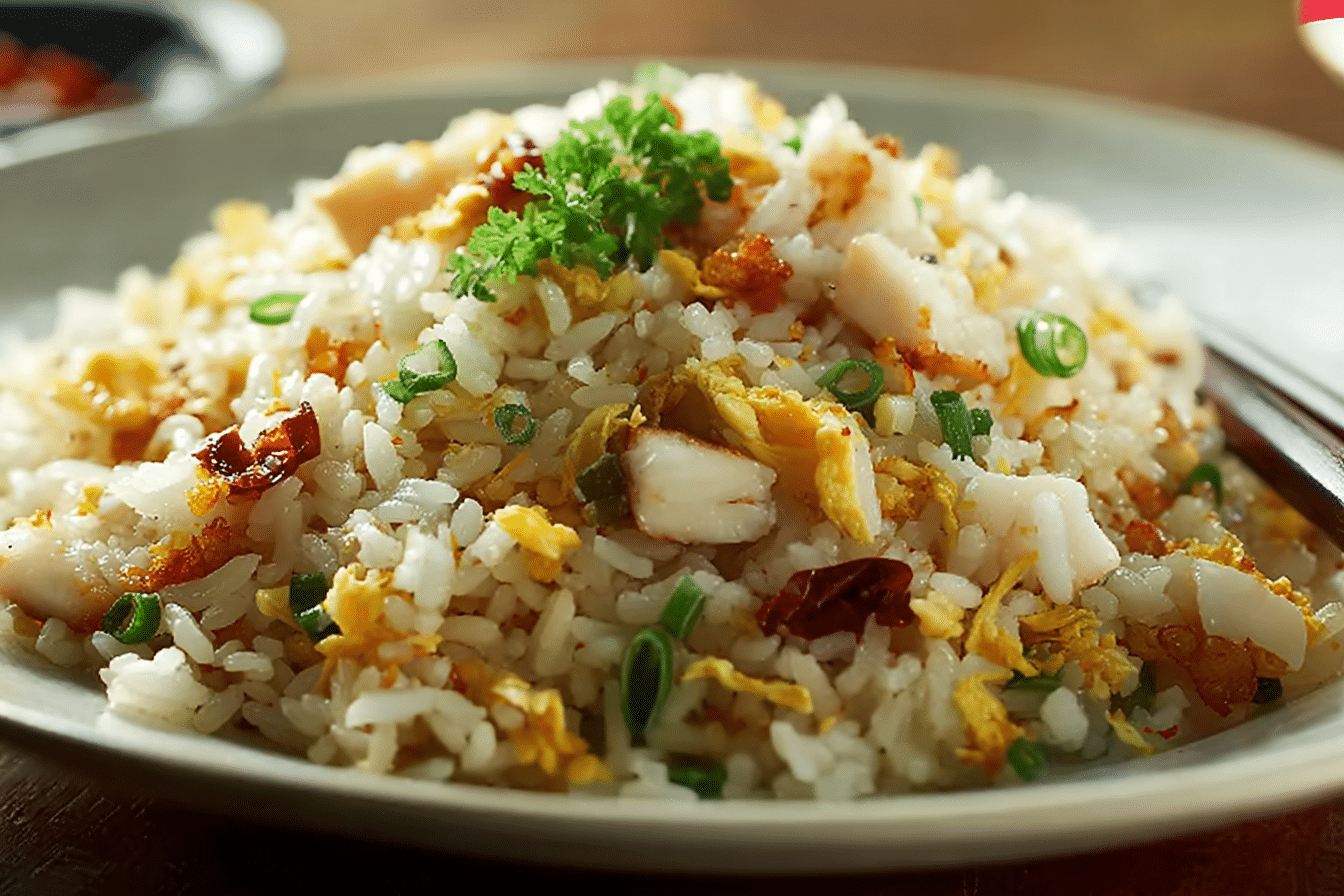
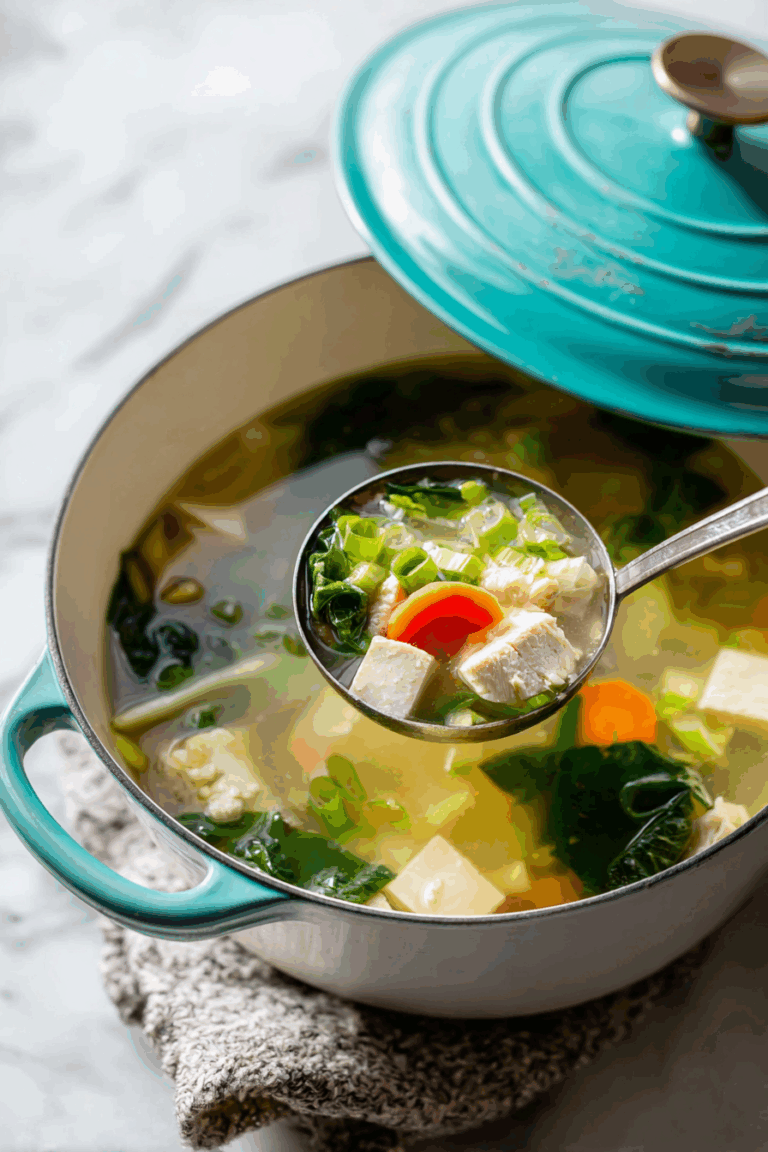
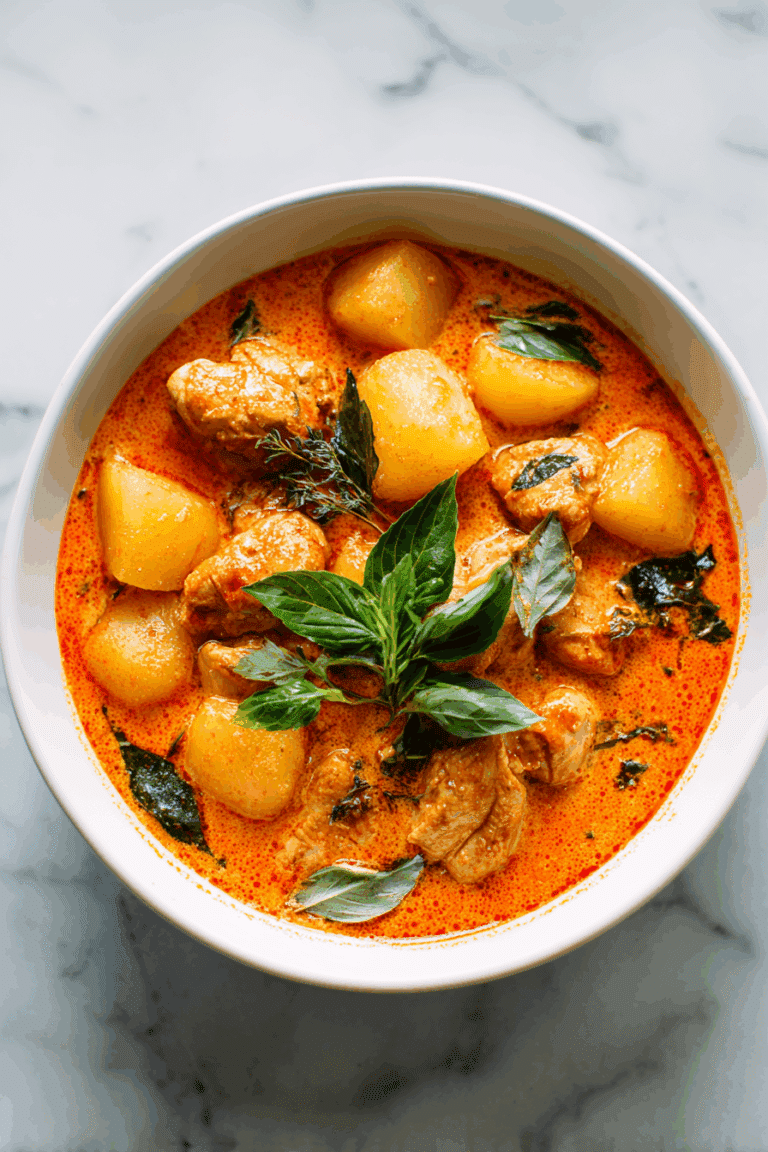
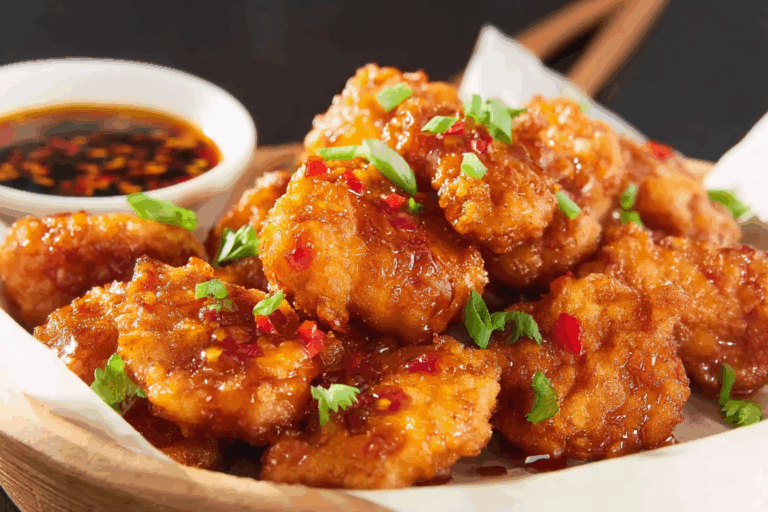
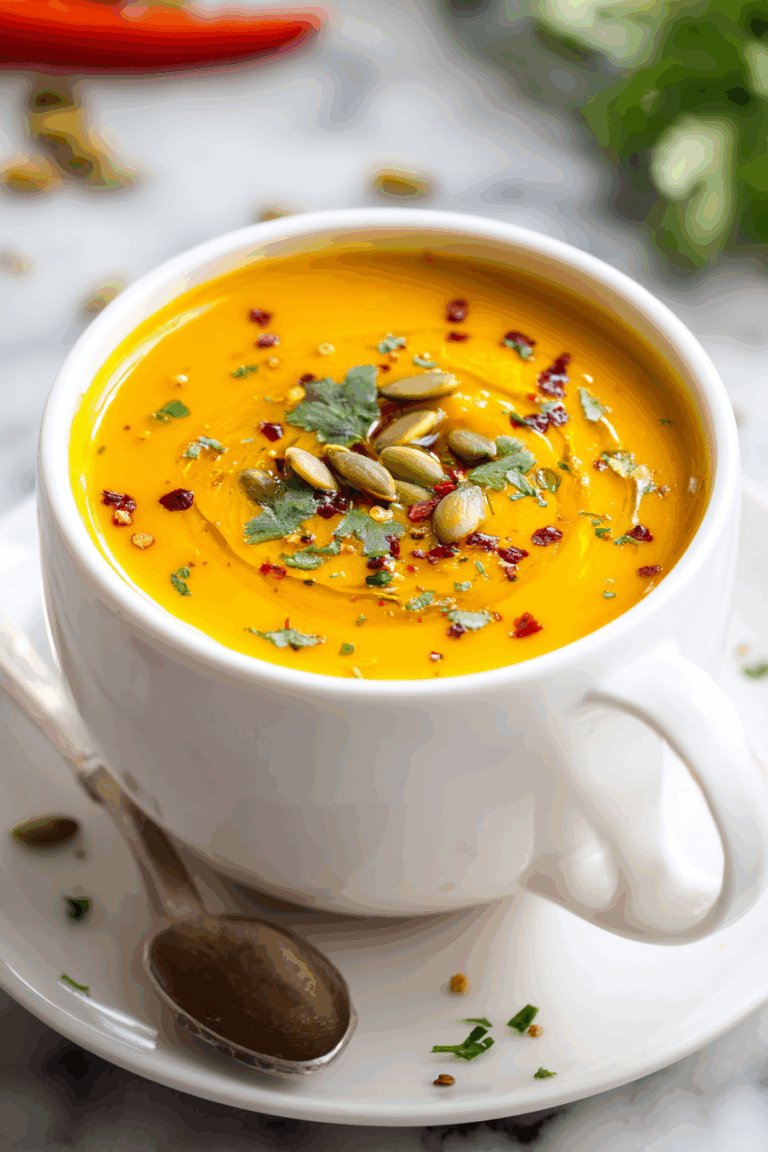
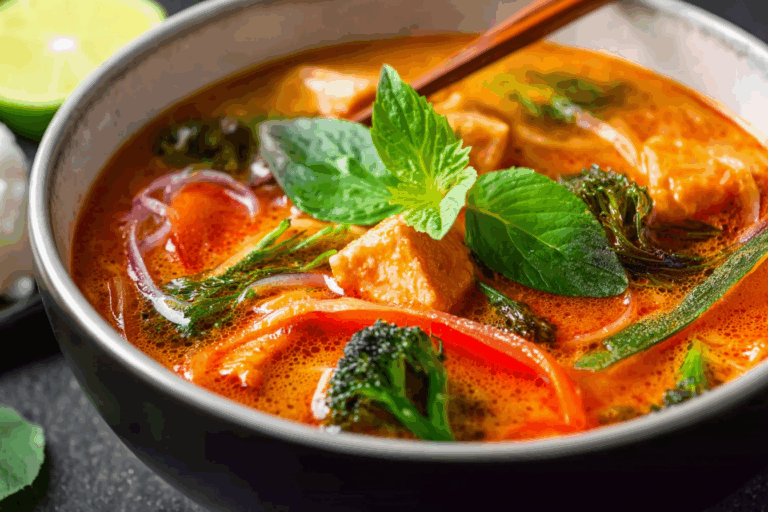
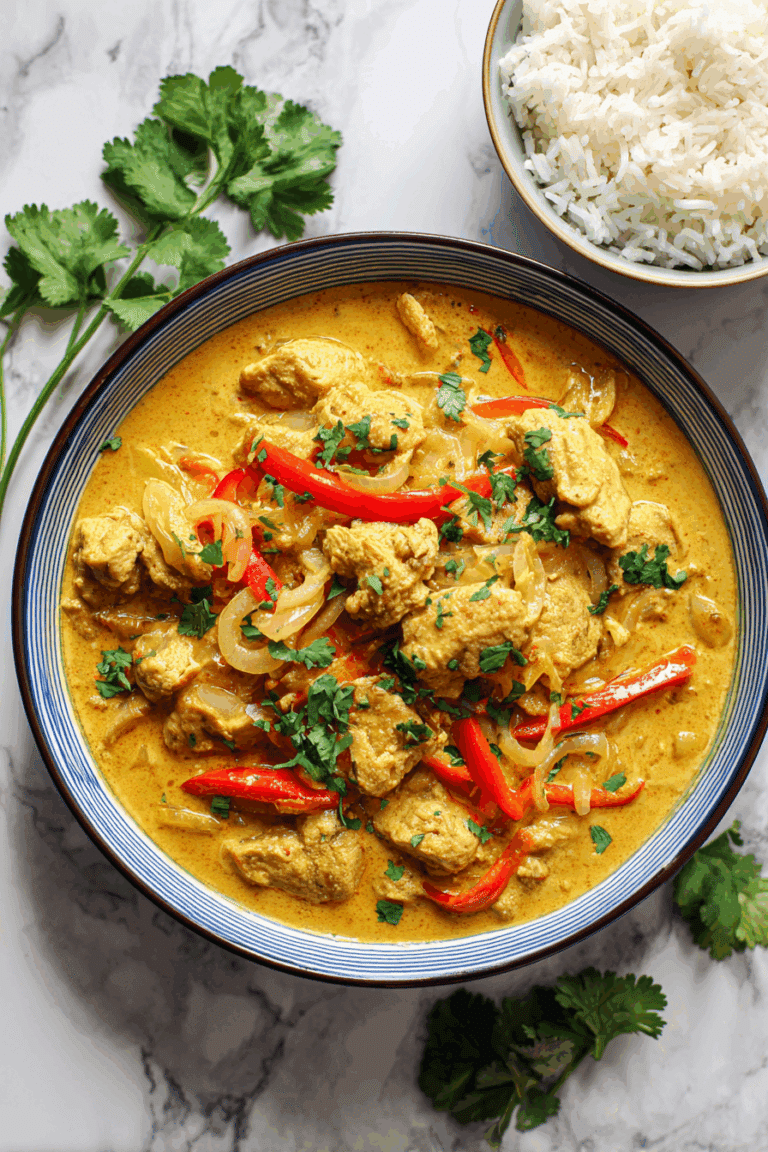
F*ckin’ remarkable things here. I am very glad to see your article. Thanks a lot and i am looking forward to contact you. Will you please drop me a e-mail?